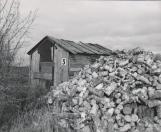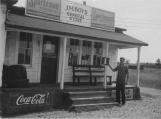14
Lawfield Full Gospel Church, 19521952
Lawfield
 Credits:
Credits:Base Gagetown Community History Association
15
Winter and early spring found most everyone in the forest looking for the next winter's firewood. Fortunate was the landowner who could rely on his own woodlot to meet his fuel needs. Of course not only did the residents need to heat their own homes, but also the churches and schools of the area. Sometimes wood was purchased but more often than not it was donated by members of the community.16
Boyd Store, Petersville, 19521952
Petersville
 Credits:
Credits:Base Gagetown Community History Association
17
Almost every community had a general store, sometimes more than one. Often a social gathering place as much as a place to shop, the country store carried goods required for day to day living. In an age when a trip to the city occurred only once or twice a year, the general store needed a good supply of materials.Pedlars sometimes traveled door to door along with more legitimate representatives such as Raleigh or Watkins. If it wasn't available locally, families could always depend upon ordering from the Eaton's Catalogue through the local merchant.
18
Washing Wool, Possibly at Petersville, about 19001900
Petersville
 Credits:
Credits:Queens County Museum Collection
19
Small, cottage-type industries rounded out the economic profile of the region. In the early years, every farm would have the capability of producing all the items necessary for survival from milk to meat to wool for making blankets and clothing. This photograph demonstrates the process of washing wool about 1900.20
Spinning Wheel, about 1850 Alice Armstrong Boyd, Summer Hill1850
Summer Hill
 Credits:
Credits:Queens County Museum Collection
21
Once washed, dried and carded, wool was spun with the use of a spinning wheel or walking wheel which would spin the wool fibers into yarn or threads for weaving.22
Coverlet, about 1850 Machum Family, New Jerusalem1850
New Jerusalem
 Credits:
Credits:Queens County Museum Collection
23
This handwoven coverlet is made from wool and cotton. Two sections of the distinctive blue and white material would be woven and then stitched together to make one large blanket.Early settlers were often proficient weavers. Over time, however, one or two members of the community would specialize in the craft and travel from house to house weaving cloth for the farmers and their wives.
This particular coverlet was woven by Amelia Jane Stockford, Hibernia for the Machum Family at New Jerusalem.